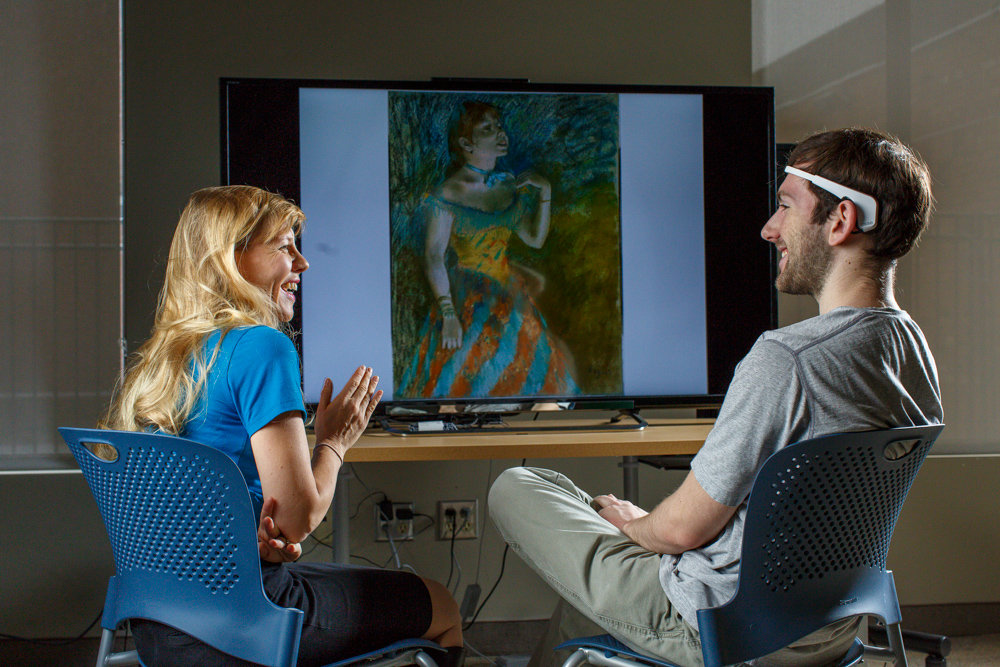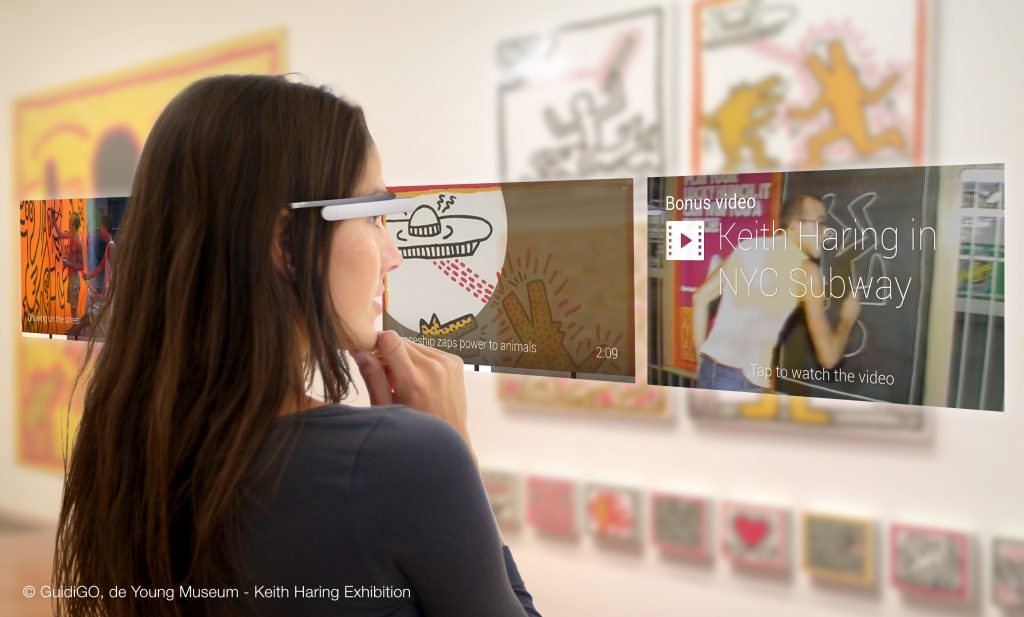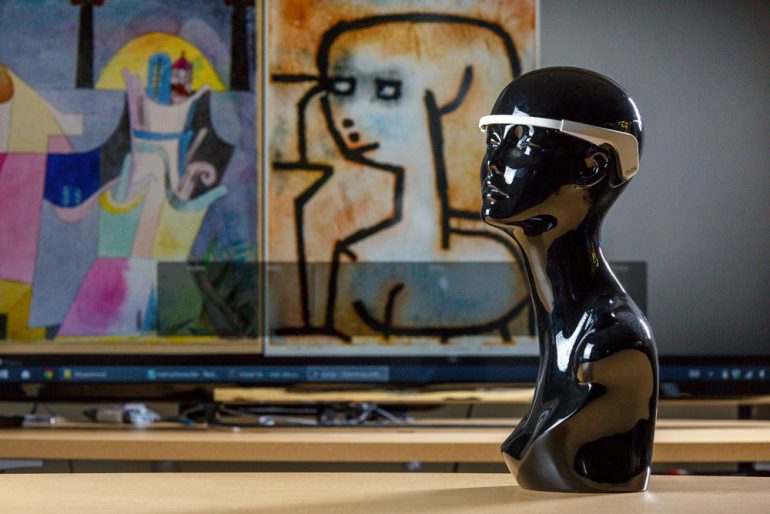Art is a very subjective thing. As William Shakespeare once said, “there is nothing either good or bad but thinking makes it so.” Whether you love it or hate it, the purpose of art is to elicit a response, but the intriguing thing about art is that the response you have may be quite different than what the artist or curator was expecting. A new project by Decimal Labs is exploring ways to sync these feelings through an interactive experience using brain-sensing wearable technology that gives art goers a chance to get inside the mind of curators and artists to create a brain-based dialogue on art.
The selection of paintings I’m shown is based on my emotions.
I am sitting at a table wearing the brain-sensing headband Muse at the MaRS Discovery District Centre. In front of me is a computer monitor displaying digitized paintings by Paul Klee, an artist known for expressionism, surrealism, and symbolism. But the selection of paintings I’m shown from this collection isn’t random, chronological or logical at all; it’s based on my emotions. At the bottom of the screen is the word “happy” and it stays that way for most of the paintings. This is by design. The paintings I’m being shown are expected to make me smile by the curator of the collection.
Using the neurocomputing power of the Muse, the iMind experience developed by Decimal Lab determines what the viewer is feeling about the art in front of them and then selects the next piece in the collection based on the emotional tags attached by the curator. The first piece I saw by Klee made me feel happy and so the program showed me other pieces the curator expected would make me feel the same way. But the subjective nature of art took the emotional conversation I was having with the curator to more than just a happy place. Certain pieces I was shown during my “happy” state didn’t keep me smiling, and when my mood changed the curator began to show me a new set of paintings in the collection that matched my new emotion.

Watching the screen to see what my emotional reaction was to a painting was an experience all on its own. I knew I was feeling positive about the painting in front of me but to have a computer program confirm how I felt brokered a new conversation with myself about why I was feeling this way, taking me deeper into my own emotional reaction to a painting. But I was not alone. The voice of the curator was extremely strong during the iMind experience, a character I often don’t think of at all when I’m at a gallery or museum. I was extremely conscious of the fact that my emotional state was either sustained or changed by how the curator thought I should feel about a piece in the Klee collection. When I was happy and happy tagged paintings were being shown to me, it felt as though the curator was beside me nodding. But when a piece entered the “happy” rotation that started to make me feel sad, I could almost see us arguing.
Adding new dimensions to the art experience is exactly what the team at Decimal Labs hopes to achieve with this experiment. “iMind is both a working prototype and an arts project that explores an alternative dialogue between viewers, art pieces, curators and artists that is meant for both in home and/or gallery viewing of digitized visual art. The ultimate goal is to explore a new brain-based dialogue between people,” explains Dr. Pedersen, director of Decimal Labs. “We wanted to explore so that the ‘voice of the gallery’ is heard at the early design phase. We want iMind to create curious, organic, dialogic, playful, inquisitive experiences when looking at traditional art.”
Decimal Labs is the digital culture and media lab at University of Ontario Institute of Technology (or UOIT), and run by Dr. Isabel Pedersen, who is also the Canada Research Chair in Digital Life, Media and Culture. The lab explores how digital technologies like wearable tech are affecting life, culture and the arts. The iMind project was just one experience they were demoing at a research event at MaRS at the end of January to illustrate how wearable tech could change the gallery and museum experience. Also at the event was a demo using META smartglasses, which elevated the museum experience using gesture and augmented reality. Decimal Labs is a META pioneer and one of the first labs in the world to be using the Microsoft HoloLens competitor. Its META Museum prototype allows users to see cultural artifacts within the Royal Ontario Museum’s iconic “Ming Tomb” by triggering digital objects to appear through the smartglasses using augmented realty markers.
The disruption of the museum and gallery experience is a major trend in wearable technology. Just recently in Los Angeles, the “world’s first virtual reality art show” was held by former Google employee turned artist, Gretchen Andrew. Andrew’s VR experience called “Alternate Reality” takes the viewer on a guided interactive tour of her paintings in the De Ro Gallery. With the viewer strapped into an Oculus Rift, they are able to walk through a virtual recreation of the gallery space and interact with the pieces, which offer bonus content such as X-ray mode to show a piece when it was a sketch, or watching a video of Andrews painting the piece you are staring at filmed through the use of a Google Glass.

Wearable tech’s most controversial device, Google Glass, could one day become commonplace at galleries and museums, replacing the audio guides we are used to seeing today. Glass at Work program partner GuidiGO has created a new storytelling platform for museum and gallery spaces which uses the heads-up diplay, beacons, and augmented reality effects to elevate the visitors experience. At the end of last year, GuidiGO partnered with the Fine Arts Museum in San Francisco to offer a Glass-driven tour of the Keith Haring exhibition, which provided visitors with music and audio interviews and visual archives on Glass as they move around the gallery.
Decimal’s iMind and META Museum, Andrew’s VR gallery, and GuidiGo’s Glass tours all have the potential to deepen and enrich the viewers experience with art while strengthening the role of the curator and artist, making them a more present participant in the experience. Even more importantly, they illustrate how wearable tech could give new life to museum and galleries by allowing users to rediscover physical art and exhibitions through digital means.
Photo credit: Kalvin Taylor/UOIT & GuidiGO

